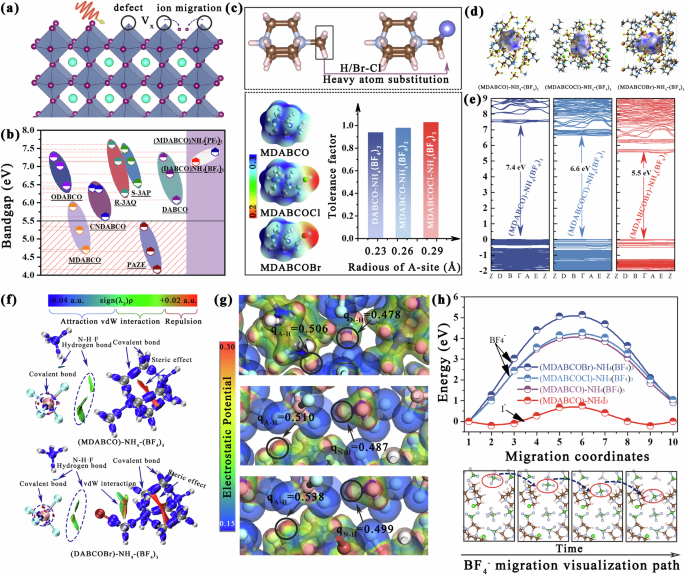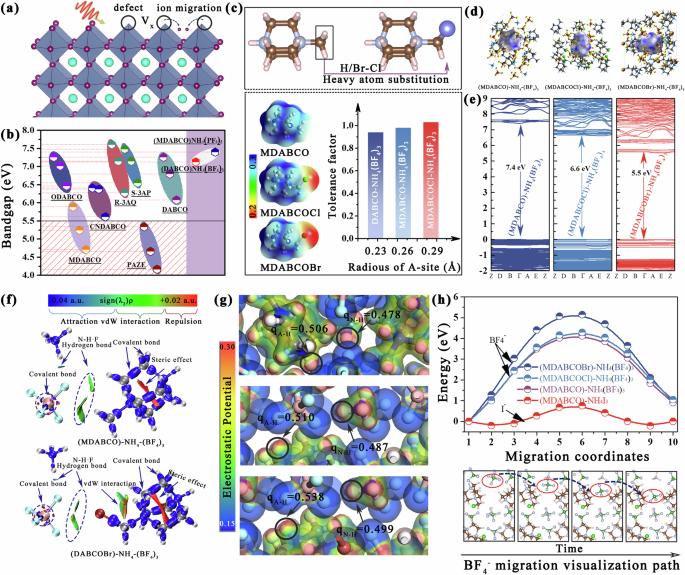Tailored molecular for ultra-stability and biocompatible pseudohalide metal-free perovskite towards X-ray detectors with record sensitivity
IF 12.3
1区 材料科学
Q1 ENGINEERING, ELECTRICAL & ELECTRONIC
引用次数: 0
Abstract
The emerging pseudohalide metal-free perovskite (pseudohalide–MFPs) X-ray detector caters to the demands of timely mobile diagnosis owing to its lightweight, flexibility, and cost-effectiveness. However, the performance of these devices is severely limited by poor X-ray absorption, ultra-wide band gap, relative instability, and their unknown biotoxicity. Herein, we construct heavy atom covalent bonds (C–Br/Cl) on the A-site organic cation to reinforce component coordination to modulate X-ray absorption and band gap in pseudohalide–MFPs and further enhance its stability. Molecular dynamics simulations demonstrate that the introduction of halogen atoms can strengthen hydrogen bonding interactions, thereby improving the coordination between different components. The resultant (MDABCOBr)–NH4(BF4)3 (MDABCO = N-methyl-N’-diazabicyclo[2.2.2]octonium) single crystal significantly increases X-ray absorption cross-section and crystalline density (from 1.728 to 1.950 g cm−3), and synergistically realizes the band nature modulation (from 7.4 to 5.5 eV) and enhanced ionic migration inhibition (628 meV) with optimized stability. As such, our X-ray detectors realized a sensitivity of 2377 μC Gyair−1 cm−2, an ultralow detection limit of 50.1 nGyair s−1, and impressive operation stability. Moreover, cytotoxicity assay confirmed the compatibility of pseudohalide metal-free perovskite. Finally, within this framework, we successfully fabricate the (MDABCOBr)–NH4(BF4)3-based flexible device to create an ideal in vitro wearable X-ray detection.


为超稳定性和生物相容性伪卤化物无金属过氧化物量身定制的分子,实现具有创纪录灵敏度的 X 射线探测器
新兴的伪卤化物无金属过氧化物(pseudohalide-MFPs)X 射线探测器因其轻便、灵活和成本效益高而满足了及时移动诊断的需求。然而,由于对 X 射线的吸收率低、带隙超宽、相对不稳定以及未知的生物毒性,这些器件的性能受到严重限制。在此,我们在 A 位有机阳离子上构建了重原子共价键(C-Br/Cl),以加强元件配位,从而调节假卤化物-MFP 的 X 射线吸收和带隙,并进一步提高其稳定性。分子动力学模拟证明,卤素原子的引入可以加强氢键相互作用,从而改善不同成分之间的配位。由此产生的 (MDABCOBr)-NH4(BF4)3 (MDABCO = N-甲基-N'-二氮杂双环[2.2.2]辛二铵)单晶显著提高了 X 射线吸收截面和晶体密度(从 1.728 g cm-3 提高到 1.950 g cm-3),并协同实现了带性质调制(从 7.4 eV 提高到 5.5 eV)和增强的离子迁移抑制(628 meV),同时优化了稳定性。因此,我们的 X 射线探测器实现了 2377 μC Gyair-1 cm-2 的灵敏度、50.1 nGyair s-1 的超低检测限和令人印象深刻的运行稳定性。此外,细胞毒性检测证实了伪卤化物无金属包晶石的兼容性。最后,在此框架内,我们成功地制造出了基于(MDABCOBr)-NH4(BF4)3 的柔性装置,创造出了一种理想的体外可穿戴 X 射线检测器。
本文章由计算机程序翻译,如有差异,请以英文原文为准。
求助全文
约1分钟内获得全文
求助全文
来源期刊

npj Flexible Electronics
Multiple-
CiteScore
17.10
自引率
4.80%
发文量
91
审稿时长
6 weeks
期刊介绍:
npj Flexible Electronics is an online-only and open access journal, which publishes high-quality papers related to flexible electronic systems, including plastic electronics and emerging materials, new device design and fabrication technologies, and applications.
文献相关原料
公司名称
产品信息
阿拉丁
methyl iodide (CH3I)
阿拉丁
hydroiodic acid
阿拉丁
Tetrafluoroboric acid
阿拉丁
methyl acetate
阿拉丁
polyvinylidene difluoride
 求助内容:
求助内容: 应助结果提醒方式:
应助结果提醒方式:


